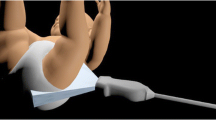Abstract
Background
The arterial vascularity of the hip has been investigated in normal infants using duplex Doppler sonography. This study addressed the differences in hip vascularity in infants with respect to gender and acetabular morphology.
Objective
To determine whether there is a relationship between the resistive index of the vessels of the femoral chondroepiphysis and the alpha angle in normal infant hips and in those with developmental dysplasia of the hip.
Materials and methods
We studied 76 hips (38 patients) with gray-scale and power Doppler US. The patients were referred because of a possible abnormal clinical hip examination or had risk factors for developmental dysplasia of the hip. The infants ranged in age from 1 day to 6 weeks. There were 13 boys and 25 girls. Gray-scale images were initially performed in the coronal and transverse planes to evaluate acetabular morphology, alpha angle and position of the femoral chondroepiphysis relative to the acetabulum. The hips were then examined with power Doppler US, in both sagittal and transverse planes, to identify arterial vessels within the femoral epiphysis. Resistive indices were then recorded from the spectral analysis in each vessel identified. Each examination was performed by one of five pediatric radiologists. Mixed model regression was used to assess the relationship between resistive index and alpha angle, age and gender.
Results
Of the 76 hips, 34 had an alpha angle of 60° or greater and were classified as normal, 26 had an alpha angle between 50° and 59° and were classified as immature, and 13 had an alpha angle of less than 50° and were either subluxed or dislocated at the time of examination. At least two vessels were documented in each femoral epiphysis except in three hips, in which no vessels could be documented because of technical factors. There was a statistically significant linear relationship between the alpha angle and resistive index, such that the resistive index tended to rise with increasing alpha angle (P=0.0022). In addition, female infants had a significantly higher average resistive index than the average resistive index in male infants with the same alpha angle (P=0.0005).
Conclusion
There is a direct linear relationship between alpha angle and resistive index in the infant hip. Female infants have a higher average resistive index than male infants. We believe that these results might serve as a model for predicting an infant hip at risk of ischemia. In addition, the fact that lower resistive indices of the femoral epiphysis are associated with acetabular dysplasia might help explain the documented low incidence of avascular necrosis in untreated hip dysplasia.




Similar content being viewed by others
References
Bearcroft P, Berman L, Robinson A, et al (1996) Vascularity of the neonatal femoral head: in vivo demonstration with power Doppler US. Radiology 200:209–211
Schwartz D, Keller M, Fields J, et al (1998) Arterial waveforms in the femoral heads of healthy neonates. AJR 170:465–466
Barnewolt C, Jaramillo D, Taylor G, et al (2003) Correlation of contrast enhanced power Doppler sonography and conventional angiography of abduction-induced hip ischemia in piglets. AJR 180:1731–1735
Taylor G, Clarke N (1997) Monitoring the treatment of developmental dysplasia of the hip with the Pavlik harness. The role of ultrasound. J Bone Joint Surg Br 79:719–723
Mubarak S, Garfin S, Vance R, et al (1981) Pitfalls in the use of the Pavlik harness for treatment of congenital dysplasia, subluxation, and dislocation of the hip. J Bone Joint Surg Am 63:1239–1248
Suzuki S, Yamamuro T (1990) Avascular necrosis in patients treated with the Pavlik harness for congenital dislocation of the hip. J Bone Joint Surg Am 72:1048–1055
Jaramillo D, Connolly SA, Vajapeyam S, et al (2003) Normal and ischemic epiphysis of the femur: diffusion MR imaging study in piglets. Radiology 227:825–832
Segal L, Boal D, Borthwick L, et al (1999) Avascular necrosis after treatment of DDH: the protective influence of the ossific nucleus. J Pediatr Orthoped 19:177–184
Author information
Authors and Affiliations
Corresponding author
Rights and permissions
About this article
Cite this article
Amodio, J., Rivera, R., Pinkney, L. et al. The relationship between alpha angle and resistive index of the femoral epiphysis in the normal and abnormal infant hip. Pediatr Radiol 36, 841–844 (2006). https://doi.org/10.1007/s00247-006-0171-9
Received:
Revised:
Accepted:
Published:
Issue Date:
DOI: https://doi.org/10.1007/s00247-006-0171-9




